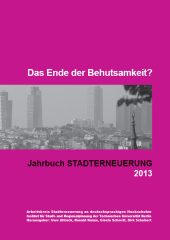Urban planning after terrorism
the case of Oslo with focus on the impacts of the terrorist attack on the consideration of security, memorialisation and conservation in urban planning

Publishing year: 2013
Terrorism is a targeted way to hurt a population but also to destroy and annihilate a part of the civilization by attacking the built environment, especially iconic and symbolic buildings with its values of collective memory and cultural heritage, which is at the latest created by the iconic act of destruction. The resilient city with its integrated plans and programs but also technical, personal or physical security aims to reduce the probability and the dimension of terrorist attacks. However attacks cannot be precluded and they leave behind open questions about their impacts on urban planning – in general and with regard to the impacted sites and their burden as tragedy sites. Terrorist attacks on symbolic buildings in Oklahoma City (United States, 1995), Manchester (United Kingdom, 1996) and – more recent – Oslo (Norway, 2011) prove that fact. The research on that cases shows, that terrorist attacks, their impacts and the overcoming do have a very individual character and will always remain a unique and incisive event where individual redevelopment prove the abnormality of those attacks, even though they increased in number in the last years. The consequence is a trend to hardened architecture and changes in urban design with impacts on public space and the appearances of cities nowadays. However the legal framework and general urban planning policy does not seem to be affected by the attacks. Terrorism is in general a reaction on the policy of the targeted country. The reasons for terrorist attacks are not to be found in the urban planning policy of a country – urban planning therefore is not in charge for combating terrorism, that is to say prevent or ward off terrorist attacks. The balance between security measures and the qualities of “freedom” and “urbanity” depends on the national politic attitude and grown self-image. This publication can give a certain contribution to the topic of terrorism and its impact on urban planning. The comprehensive analysis of Oslo gives a summary about the future of the Regjeringskvartalet with regard to the consideration of factors such as security, cultural heritage, memorial values, economic aspects and planning process design. Although an explicit result of Oslo´s future is not quite clear yet and possible further impacts on urban planning in Oslo are not evident at this time certain tendencies could be identified with the help of the experts. Also the combined reflection of three, under certain points of view similar cases shows different ways of dealing with a traumatic shock.



